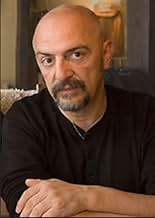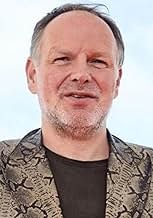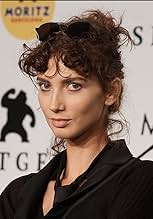Lux Æterna
- 2019
- 51 min
AVALIAÇÃO DA IMDb
6,2/10
8,3 mil
SUA AVALIAÇÃO
Duas atrizes em um set de filmagem contam histórias sobre bruxas.Duas atrizes em um set de filmagem contam histórias sobre bruxas.Duas atrizes em um set de filmagem contam histórias sobre bruxas.
- Prêmios
- 1 indicação no total
Avaliações em destaque
The "Lux Aeterna" (18+) is one more cinematic experiment from Gaspar Noé. Noe gained the worldwide fame in 2002, thanks to the scandalous film "Irreversibility" with Monica Bellucci and Vincent Cassel.
"Lux Aeterna" grew out of a collaboration between Saint Laurent and Gaspar Noé, the master of light and audience reactions, it is a surreal and hysterically beautiful narrative of a day on the set of a film about the Inquisition in the underground aesthetics of the 1990s. The shimmering light and quotes from Dostoevsky, Godard, Fassbinder and other iconic figures add contrasts to the film.
Two icons of French cinema of the last decades, Beatrice Dalle and Charlotte Gainsbourg, are the driving mechanisms of the film. At first, they improvise in the dialogue, where they are ironic and exaggerative, but they tell about the creative underside of almost any film or production, and later they heat up emotional tension to the level of the atrocities of the Inquisition or hellish cauldrons. The aesthetic is amazing: crosses and bonfires, Charlotte in a Saint Laurent dress and the insane energy of Beatrice, covering even the madness of light and music at the end of the film. Beatrice is the witch in this story: charismatic, bright, even weird and uncomfortable for others, and the film within the film is her brainchild, which others are trying to appropriate.
The film turned out to be stylish and a bit provocative: about fashion and its victims, about vices and the fact that not everything is so simple with them, and, finally, about human selfishness. A neon beam pierces the "Lux Aeterna" with the truth that witches have a hard time even in the 21st century, because the crowd is always ready to lynch.
"Lux Aeterna" grew out of a collaboration between Saint Laurent and Gaspar Noé, the master of light and audience reactions, it is a surreal and hysterically beautiful narrative of a day on the set of a film about the Inquisition in the underground aesthetics of the 1990s. The shimmering light and quotes from Dostoevsky, Godard, Fassbinder and other iconic figures add contrasts to the film.
Two icons of French cinema of the last decades, Beatrice Dalle and Charlotte Gainsbourg, are the driving mechanisms of the film. At first, they improvise in the dialogue, where they are ironic and exaggerative, but they tell about the creative underside of almost any film or production, and later they heat up emotional tension to the level of the atrocities of the Inquisition or hellish cauldrons. The aesthetic is amazing: crosses and bonfires, Charlotte in a Saint Laurent dress and the insane energy of Beatrice, covering even the madness of light and music at the end of the film. Beatrice is the witch in this story: charismatic, bright, even weird and uncomfortable for others, and the film within the film is her brainchild, which others are trying to appropriate.
The film turned out to be stylish and a bit provocative: about fashion and its victims, about vices and the fact that not everything is so simple with them, and, finally, about human selfishness. A neon beam pierces the "Lux Aeterna" with the truth that witches have a hard time even in the 21st century, because the crowd is always ready to lynch.
I support the evolution of art. In order for things to move forward, you need provocateurs to rock the foundation of what's deemed acceptable. Art made strictly to appeal to what already works is boring. Lvx Æterna embodies the rebellious spirit of creation, even if the results are borderline unwatchable.
Opening on a rambling conversation that lasts far too long then moving to a perplexing split screen where multiple scenes play simultaneously, often including different dialogue in different languages, all before a seizure inducing assault of light and sound. Gaspar Noé is screaming in your face, daring you to turn off his movie, and whether you do or not, you can't deny it's visceral impact.
The man is off in his own stratosphere, there really are no peers or precedents for this aesthetic. While his other work may offer more narrative meat, often coupled by more disturbing violence, this one seems to be a pure, unrefined shot of the disorienting bliss he's known for.
Like many forms of extreme music that seem to exist for the express purpose of pushing boundaries, it's a challenging experience that won't be for all tastes or moods. It's just a refreshing reminder that there's still untapped potential for defiant confrontational cinema.
Opening on a rambling conversation that lasts far too long then moving to a perplexing split screen where multiple scenes play simultaneously, often including different dialogue in different languages, all before a seizure inducing assault of light and sound. Gaspar Noé is screaming in your face, daring you to turn off his movie, and whether you do or not, you can't deny it's visceral impact.
The man is off in his own stratosphere, there really are no peers or precedents for this aesthetic. While his other work may offer more narrative meat, often coupled by more disturbing violence, this one seems to be a pure, unrefined shot of the disorienting bliss he's known for.
Like many forms of extreme music that seem to exist for the express purpose of pushing boundaries, it's a challenging experience that won't be for all tastes or moods. It's just a refreshing reminder that there's still untapped potential for defiant confrontational cinema.
Possibly the film in which Gaspar Noé most clearly shows his concept of cinema. The shooting is hell, even more than the staging. The need to challenge the comfort of the viewer (in the images and in the narration) is again present, in the different points of view. His vision surrounds the campaign of a fashion brand with mystery, which continues with the short film "Summer of '21" (2020), starring Charlotte Rampling. Only a director like Gaspar Noé can turn witches into Yves Saint Laurent models. "Sexocide: the genocide of the witches".
7 months after its premiere in Cannes (which I attended), I can't believe there is still no review of Lux Aeterna, so here is mine:
I think this film is admirable in many ways although not devoid of flaws, the main one being that for the nth time, Noé pulls the same expectable tricks with colorful lighting, flickering images and references to his classics (even just the title, "Lux Aeterna" is the György Ligeti eerie choir piece used in "2001: A Space Odyssey"), etc. So that does get a little unimaginative, especially since the atmosphere and development are very close to his latest long feature, "Climax".
That said, everything else is interesting. From the Dalle / Gainsbourg improvised dialogue (made hilarious by Dalle's very personal way of saying things - let's hope that won't get lost in translation) to the creative ways in which Noé uses the screen space. I couldn't stress this enough: *This Must Be Watched In A Movie Theater* ! Although I do enjoy smaller screens, I'm afraid a small screen won't cut it with this one. As usual with Noé, the experimental elements are present and the big screen is a must in order to enjoy them fully.
Many references are made throughout the film to Carl Dreyer's classic "Vredens Dag" from 1943, also using footage from it. It does serve a purpose but cannot really be discussed without spoiling.
I believe many interpretations of the film are possible. From mysogynistic to feminist. I'm definitely going with the latter. The end scene is intense in symbolism, deafening sound, flickering visuals and a creative use of the screen. If you suffer from epilepsy: STAY AWAY. As usual, Noé tries our patience and is into trying to shock us - but that's getting a bit old. Nothing gory though, so the faint of heart can watch. The camera flies from room to room as the crescendo builds up progressively until smothering hysteria. The film only lasts 50mn but it wouldn't necessarily have made more sense to make it any longer.
This is also definitely a film about film-making and how things go, on and off set. It's a film about actresses - how some can impose their strength or choose to go with what is asked of them.
This film will divide. Some will see it as arty, vaccuous and pointless. Others will find depth and meaning in it, but not necessarily the same meaning. I believe this is the best Noé film in a long time. Overall better than "Climax" or "Love". If you can get past Noé's antics, it is not only enjoyable, it is mostly an undeniable breath of fresh air in contemporary cinema.
I think this film is admirable in many ways although not devoid of flaws, the main one being that for the nth time, Noé pulls the same expectable tricks with colorful lighting, flickering images and references to his classics (even just the title, "Lux Aeterna" is the György Ligeti eerie choir piece used in "2001: A Space Odyssey"), etc. So that does get a little unimaginative, especially since the atmosphere and development are very close to his latest long feature, "Climax".
That said, everything else is interesting. From the Dalle / Gainsbourg improvised dialogue (made hilarious by Dalle's very personal way of saying things - let's hope that won't get lost in translation) to the creative ways in which Noé uses the screen space. I couldn't stress this enough: *This Must Be Watched In A Movie Theater* ! Although I do enjoy smaller screens, I'm afraid a small screen won't cut it with this one. As usual with Noé, the experimental elements are present and the big screen is a must in order to enjoy them fully.
Many references are made throughout the film to Carl Dreyer's classic "Vredens Dag" from 1943, also using footage from it. It does serve a purpose but cannot really be discussed without spoiling.
I believe many interpretations of the film are possible. From mysogynistic to feminist. I'm definitely going with the latter. The end scene is intense in symbolism, deafening sound, flickering visuals and a creative use of the screen. If you suffer from epilepsy: STAY AWAY. As usual, Noé tries our patience and is into trying to shock us - but that's getting a bit old. Nothing gory though, so the faint of heart can watch. The camera flies from room to room as the crescendo builds up progressively until smothering hysteria. The film only lasts 50mn but it wouldn't necessarily have made more sense to make it any longer.
This is also definitely a film about film-making and how things go, on and off set. It's a film about actresses - how some can impose their strength or choose to go with what is asked of them.
This film will divide. Some will see it as arty, vaccuous and pointless. Others will find depth and meaning in it, but not necessarily the same meaning. I believe this is the best Noé film in a long time. Overall better than "Climax" or "Love". If you can get past Noé's antics, it is not only enjoyable, it is mostly an undeniable breath of fresh air in contemporary cinema.
... though it may just get you twitching.
A number of patients in a high security psychiatric hospital decide to make a short film. Conscious of the fact that in medieval times they would most likely have been considered witches or warlocks, since their behaviour could only be interpreted as such during those times, they place the punishment for such behaviour at the centre of their creation.
Fortunately, as luck would have it, the split screen personality allows the viewer to gorge on twice as much pagan pantomime than would normally be recommend but, since this piece occupies slightly less than an hour, they just about get away with it, although that may depend on the medication you're currently prescribed.
You'll be pleased when the credits role, although it's unlikely you'll make it through to the end.
A number of patients in a high security psychiatric hospital decide to make a short film. Conscious of the fact that in medieval times they would most likely have been considered witches or warlocks, since their behaviour could only be interpreted as such during those times, they place the punishment for such behaviour at the centre of their creation.
Fortunately, as luck would have it, the split screen personality allows the viewer to gorge on twice as much pagan pantomime than would normally be recommend but, since this piece occupies slightly less than an hour, they just about get away with it, although that may depend on the medication you're currently prescribed.
You'll be pleased when the credits role, although it's unlikely you'll make it through to the end.
Você sabia?
- CuriosidadesParamedics were waiting outside of the premier at Cannes Film Festival, in case audience members would become sick or faint during the screening.
- Cenas durante ou pós-créditosThe end credits were stylized Latin script used in the Middle Ages (e.g. with the letter "v" instead of "u") - This is how the title itself is written: Lvx Æterna. All the actor names included first names only, no family names. As the director himself said, in the times when Latin language was used, people didn't use surnames (family names), so he decided to put only first names in the end credits.
- ConexõesFeatures Häxan - A Feitiçaria Através dos Tempos (1922)
Principais escolhas
Faça login para avaliar e ver a lista de recomendações personalizadas
- How long is Lux Æterna?Fornecido pela Alexa
Detalhes
Bilheteria
- Faturamento bruto nos EUA e Canadá
- US$ 50.027
- Fim de semana de estreia nos EUA e Canadá
- US$ 8.945
- 8 de mai. de 2022
- Faturamento bruto mundial
- US$ 323.829
- Tempo de duração51 minutos
- Cor
- Proporção
- 1.33 : 1
- 2.35 : 1
Contribua para esta página
Sugerir uma alteração ou adicionar conteúdo ausente



![Bande-annonce [OV]](https://m.media-amazon.com/images/M/MV5BMWM2MzRmZmUtY2YxYy00ZTNhLTkwMDgtYWM0NDA0NDlhMDQzXkEyXkFqcGdeQXRyYW5zY29kZS13b3JrZmxvdw@@._V1_QL75_UX500_CR0)
































